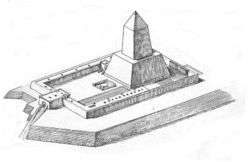Egyptian sun temple

Egyptian sun temples were Ancient Egyptian temples to the sun god Ra. The term has come to mostly designate the temples built by six or seven pharaohs of the Fifth Dynasty during the Old Kingdom period. These sun temples were built in two localities, Abu Gorab and Abusir, both within 1 km (0.62 mi) of each-other and around 15 km (9.3 mi) south of modern-day Cairo. Of the six or seven temples built, only two have been uncovered: that of Userkaf and that of Nyuserre Ini. Both are now in ruins, although the temple of Nyuserre still holds impressive remains, in particular its central altar piece.
History of construction
The early to mid Fifth Dynasty[1] was marked by an especially strong devotion to the sun god Ra, whose cult was based at Heliopolis (Egyptian: Annu or Iunu). The founder of the Fifth Dynasty, Userkaf, built the first temple to Ra in Abusir, a few kilometers North of the necropolis of Saqqara, where he had built his pyramid. Userkaf's practice was followed by all his successors until Djedkare Isesi, some 80 years later, with one possible exception--Shepseskare--owing to his ephemeral rule. In total, the following temples were built:
- Nekhenre, "The fortress of Re", built by Userkaf
- Sekhetre, "The field of Re", built by Sahure
- Setibre, "The favourite place of Re", built by Neferirkare Kakai
- Hetepre, "The offering place of Re", built by Neferefre
- Conjectural: Hotepibre, "Satisfied is the heart of Re", started by Shepseskare
- Shesepibre, "Joy of the heart of Re", built by Nyuserre Ini
- Akhetre, "The horizon of Re", built by Menkauhor Kaiu.
Only the solar temples of Userkaf and Nyuserre have been discovered today. Nyuserre's temple contains a large catalogue of inscriptions and reliefs from this king's reign.
Design
Each temple was designed after the one at Heliopolis with an altar in front of an obelisk with a pyramid tip. The obelisk, called a benben, stood on a low platform at one end of the temple and was 70 metres (230 ft) tall. The exact purpose of these sun temples is unclear. Because they were architecturally built to contain a mortuary temple, a valley temple, and a connecting causeway, they may have been used to worship the god Ra (or Re).
The sun temple of Nyuserre is the best preserved. Its platform is still intact with pieces of the benben still lying on the ground. Nine of the ten offering basins are also intact. The offering basins were used to hold sacrificial animal blood, which ran through channels cut into the paving. Contemporary Egyptian records give the names of six sun temples ascribed to six pharaohs of the Fifth Dynasty. While the locations of five of these temples have been discovered, only two of the six aforementioned structures have been identified and investigated thus far. Both of them are situated in North Abusir. The surviving remains of these temple complexes reflect peculiar similarities within royal mortuary complexes as far as their architecture is concerned.
References
- ↑ Robert G Morkot, The Egyptians: An Introduction. pp. 223